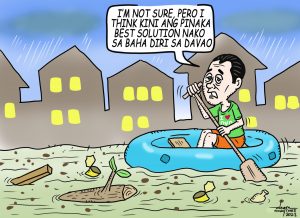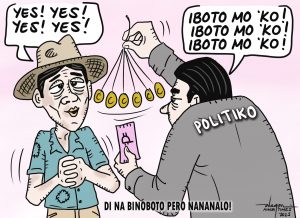We are still not through with our thoughts on history, especially on that of our beloved adopted City of Davao.
Isn’t it that in a little over a month Davaoeños will be celebrating their “Araw ng Dabaw” to commemorate the founding of the City as a chartered local government unit? And one of its featured activities is the selection of this year’s Datu Bago Awardee or awardees.
Who is Datu Bago? Why is he given that very honored privilege to carry the name of the city’s most prestigious award given to its deserving citizens?
From our readings of Davao’s history books, Datu Bago was the native chieftain who ruled Davao at the time the Spaniards started their colonization drive in this part of Mindanao. Datu Bago made it extremely difficult for the Spanish conquistadors led by Don Jose Oyangoren to gain foothold on the Davao mainland.
According to the history books we read, Datu Bago’s center of dominion was believed to be the area that encompasses the present Bankerohan market and its surrounding community. During that time, and even until today, the location is very strategic. It is elevated and is overlooking the Davao Bay and the mouth of what is now the Davao River.
So, the Spanish invaders’ boats can already be seen when these were poised to launch attacks on the native chieftain’s position. Had not Oyangoren befriended the Samal natives and got their support in his repeated attacks on Datu Bago’s defense lines he would not have succeeded in coming to the Davao mainland.
Because of the chronicled heroics of the native chieftain he had been considered a local hero. That concrete recognition was started during the time of then Davao City Mayor, the late Elias Baguio Lopez.
Lopez himself was the first ever indigenous person or Davao lumad to be elected mayor of the city. He started the Datu Bago Award.
However, even as Datu Bago’s name became a by-word in the city even more because of the prestigious award, his being a native hero was made official only a year or so ago. Such recognition was made by way of an ordinance officially declaring Bago as the city’s hero for defending to the death what then was the independence of Davao from any foreign or local invaders.
Until today though, the Davao Historical Society to which we are made part of its Board of Trustees since a week ago, admits that the local hero is yet to be honored with a monument that could enhance his perpetuation in the consciousness of the Davaoeños. But while there may be monuments of the man in some areas of the city, one of them in Calinan, the locations may not give justice to what he is being honored about.
Personally we believe that if a new monument is erected in honor of the Davao defender against the Spanish colonizers, it should be located somewhere in Bankerohan where his rule was headquartered. And it must stand on a more conspicuous site for people to see. And the monument must be maintained and the hero given remembrance ceremony on a date of the year that may have relevance to the life he lived.
Really, we could not imagine why a large and financially established city like Davao somehow failed miserably in providing some kind of a memorial site to honor a person many considered to have done something worth instilling in the minds of every Davao resident.
Why has Davao City failed to do such accolade when Carmen town in Davao del Norte, a far poorer local government, was able to put up a memorial for the bravery and courage of the Filipino soldiers who fought the Japanese tooth and nail in what is now termed as the “Battle of Ising?” In the memorial site stands the monument of the man who led against the onslaught of the Japanese soldiers in the Second World War in that part of the still undivided Davao Province.
We are looking forward to the realization of councilor Pilar Braga’s dream for the city to put up a worthy monument of Datu Bago soonest. After all, we know that the organization that she chairs will be standing four squares behind her.
Isn’t it ironic that Davao City spent a fortune to put up at the vicinity of the Rizal Park near City Hall a giant replica of the eagle which is now the country’s national bird but seemingly forget to build one for its native hero on a place deserving for the man?
And will it not also give justice to Davao City if its own history is to be included in the same subject to students? The students sure want to reach the destination they want to go. And how can they if they are not given the proper tools to look back to where they came from?


